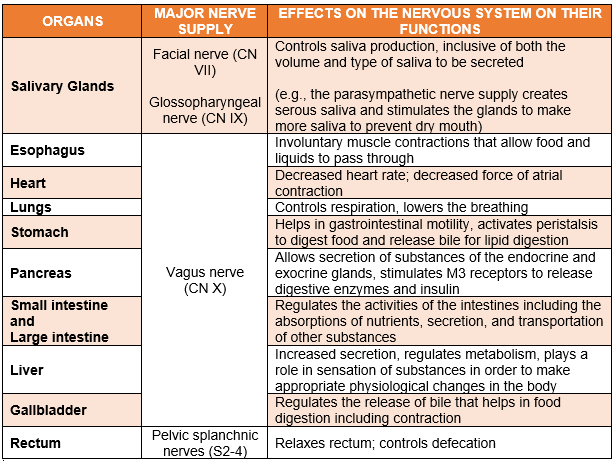Activity 3
1. You have been to an ‘eat all you can’ buffet and have consumed large amounts of food. After returning home, you recline on the couch to watch television. Which division of the nervous system will be handling your body’s after-dinner activities? List several organs involved, the major nerve supply to each organ, and the effects of the nervous system on their functions.
The division of the nervous system that will be handling the body’s after-dinner activities (eat all you can buffet) would be controlled by increased stimulation of the parasympathetic nervous system. The parasympathetic nervous system stimulates rest-and-digest activities, which help the body preserve and replenish energy when it's time to rest or digest food.
The following organs are involved in this process, as well as the major nerves that supply them, and the effect of the nervous system on their functions.

2. Your friend is driving home from work, listening to her favorite music, when suddenly a bicycle came out of nowhere. She manages to swerve avoiding hitting the bicycle. She continued to drive home but she noticed that her heart is beating fast, she had goose bumps, and her heads were sweaty. How would you explain these effects?
We can see from the scenario above that my friend, who is driving, avoided hitting the bicycle because she was listening to her favorite music, which helped her to relax and calm her nerves. The sudden appearance of a bicycle, which nearly put her in an “E situation” (emergency situation), however, changes her mind into a state of panic which activated her sympathetic nervous system, which is responsible for the body's fight-or-flight response.
The flight-or-flight response is our natural survival mechanism that comes when we detect a stressful or dangerous environment or situation. It becomes more active, powerful, and awake in response to challenging difficulties that put one’s life in danger. This happens when the amygdala, a part of the brain involved in processing emotions, sends a distress signal to the hypothalamus when a stressful event occurs. Then, the nervous system serves as a command center, communicating with the body as a whole to provide the individual the strength to fight or escape.
Some noticeable effects of increased sympathetic activity from my friend’s case include an increase in heart rate, sweating on the palms, and contraction of the arrector pili muscles, which causes goose flesh.
References:
McCorry, L. K. (2007, September). Physiology of the Autonomic Nervous System. American Journal of Pharmaceutical Education, 71(4), 78. https://www.ncbi.nlm.nih.gov/pmc/articles/PMC1959222/
Tortora, G. J., & Derrickson, B. (2017). Principles of Anatomy & Physiology. Fifteenth edition; Wiley Loose-Leaf Print Companion. Hoboken, New Jersey, John Wiley & Sons, Inc